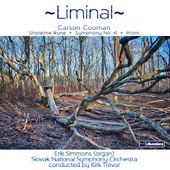

1} Shoreline Rune, Op. 1083 (2014)
2} Liminal (Symphony No. 4), Op. 1068 (2014)
3} Prism, Op. 522 (2003)
The first time I listened to the Symphony No. 4 'Liminal', Op. 1068 by American composer Carson Cooman (b. 1982), I wasn't sure what to make of
it. You may have noticed that I was very impressed by some recent recordings of his organ works, reviewed here and
here, but I must admit that I was somewhat disconcerted and perplexed upon listening to this symphonic work. But
after living with it now over the last four weeks or so, I cannot shake its grip on me. I've listened to it so many times now that I can literally replay most of it in my head while at work. That's
quite the feat when you take into consideration the fact that it doesn't really contain much in the way of cyclical melodies or motifs. Its nebulous atmosphere is what pulls you in.
Dictionaries define the term Liminal as being a transitional state, of being between states, a treshold, existing at the limen. Tibetan Buddhists see it as the state
of the soul between its death and its rebirth. Carson Cooman applies it here as the liminal state our planet is going through due to climate change. In this case, I myself perceive this liminal
treshold as possibly being the 'point of no return' for our planet. The musical process of this work is very organic, elemental and primitive, as nature slowly changing would be. The muted brass,
hollow thuds, slithering and skittering strings, and an out-of-tune harp that open this one movement symphony, certainly wrap everything in a cloak of dread and ill prescience. From there, it
gradually builds and increases in tension until the brass section releases a startling amount of energy just after the midpoint, repeat it once more, then the tension releases and the bleak atmosphere
returns. The concluding few strands in the upper strings sound like the final glacial exhalation of a desolate, lifeless planet. It leaves an imprint on your conscience.
The two other works on this recording certainly bookend the symphony very well. Shoreline Rune for string orchestra and harp, which opens the CD, sets the tone
as it dwells within the same dark and desolate imagery that is to follow, while Prism for organ, with its long, sustained, ambiguous open interval chords, further makes you ponder
the contemplative state of mind, possibly liminal state, left behind by the symphony.
Jean-Yves Duperron - October 2015